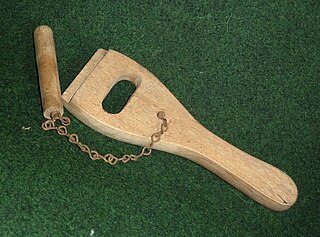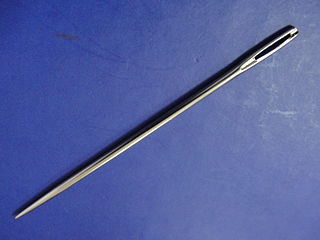
The Worshipful Company of Upholders is one of the Livery Companies of the City of London. "Upholder" is an archaic word for "upholsterer". In past times, upholders did not just manufacture and sell upholstered goods but were cabinet makers, undertakers, soft furnishers, auctioneers, and valuers. The organisation was formed on 1 March 1360 and officially incorporated by a Royal Charter granted by Charles I in 1626. The Company originally had the right to set standards for upholstery within London and to search, seize and destroy defective upholstery. However, over the years, the Company's power has eroded, as has the profession of upholsterers, because of the advancement of technology.

Upholstery is the work of providing furniture, especially seats, with padding, springs, webbing, and fabric or leather covers. The word also refers to the materials used to upholster something.

A slipcover is a fitted protective cover that may be slipped off and onto a piece of upholstered furniture. Slipcovers are usually made of cloth. Slipcovers slip on and off; they come fresh and may be removed for seasonal change, cleaning, moving, or storage.

A staple gun or powered stapler is a hand-held machine used to drive heavy metal staples into wood, plastic, or masonry. Staple guns are used for many different applications and to affix a variety of materials, including insulation, house wrap, roofing, wiring, carpeting, upholstery, and hobby and craft materials. These devices are also known as trigger tackers.

A webbing stretcher is an upholstery tool used to stretch webbing.

An upholstery hammer is a lightweight hammer used for securing upholstery fabric to furniture frames using tacks or small nails.

A pincushion is a small, stuffed cushion, typically 3–5 cm (1.2–2.0 in) across, which is used in sewing to store pins or needles with their heads protruding to take hold of them easily, collect them, and keep them organized.

A sewing needle, used for hand-sewing, is a long slender tool with a pointed tip at one end and a hole to hold the sewing thread. The earliest needles were made of bone or wood; modern needles are manufactured from high carbon steel wire and are nickel- or 18K gold-plated for corrosion resistance. High-quality embroidery needles are plated with two-thirds platinum and one-third titanium alloy. Traditionally, needles have been kept in needle books or needlecases which have become objects of adornment. Sewing needles may also be kept in an étui, a small box that held needles and other items such as scissors, pencils and tweezers.
Upholstery coil springs are an important part of most modern upholstery. The consumer usually never sees the construction features of an upholstered piece. The overall quality of the materials and construction dictate the comfort level of an upholstered piece and its ability to satisfy the consumer over the long term. A basic upholstered piece may be composed of a frame, springs, foam, cushioning, padding, and textiles.
Cretonne was originally a strong, white fabric with a hempen warp and linen weft.

Tufting is a type of textile manufacturing in which a thread is inserted on a primary base. It is an ancient technique for making warm garments, especially mittens. After the knitting is done, short U-shaped loops of extra yarn are introduced through the fabric from the outside so that their ends point inwards.

Wood wool, known primarily as excelsior in North America, is a product made of wood slivers cut from logs. It is mainly used in packaging, for cooling pads in home evaporative cooling systems known as swamp coolers, for erosion control mats, and as a raw material for the production of other products such as bonded wood wool boards. In the past it was used as stuffing, or padding, in upholstery, or to fill stuffed toys. It is also sometimes used by taxidermists to construct the armatures of taxidermy mounts.
The Upholsterers were an American garage punk band in 2000, from Detroit, Michigan. The two-piece band was composed of Jack White and Brian Muldoon of The Muldoons. Muldoon provided drums, while White played on guitar and created sounds with a worm gear saw. They were originally called Two Part Resin.

A needlegun scaler, needle scaler, or needle-gun is a tool used to remove rust, mill scale, and old paint from metal surfaces. The tool is used in metalwork applications as diverse as home repair, automotive repair, and shipboard preservation.
The Auto Care Association is a not-for-profit trade association based in Bethesda, Maryland. Auto Care Association's nearly 3,000 members and affiliate companies, represent approximately 150,000 businesses that manufacture, distribute, sell and install motor vehicle parts, accessories, tools, equipment, materials, supplies, and services. Representing suppliers, distributors, retailers, service providers, program groups, manufacturers’ representatives, educators, and publishers, the Auto Care Association protects and advances the interests of businesses providing aftermarket products and services for all classes of motor vehicles.

The term Provençal quilting, also known as boutis, refers to the wholecloth quilts done using a stuffing technique traditionally made in the South of France from the 17th century onwards. Boutis is a Provençal word meaning 'stuffing', describing how two layers of fabric are quilted together with stuffing sandwiched between sections of the design, creating a raised effect. The three main forms of the Provençal quilt are matelassage, piqûre de Marseilles, and boutis. These terms, along with trapunto are often debated and confused, but they are all forms of stuffed quilting associated with the region.

A tick mattress, bed tick or tick is a large bag made of strong, stiff, tightly-woven material (ticking). This is then filled to make a mattress, with material such as straw, chaff, horsehair, coarse wool or down feathers, and less commonly, leaves, grass, reeds, bracken, or seaweed. The whole stuffed mattress may also, more loosely, be called a tick. The tick mattress may then be sewn through to hold the filling in place, or the unsecured filling could be shaken and smoothed as the beds were aired each morning. A straw-filled bed tick is called a paillasse, palliasse, or pallet, and these terms may also be used for bed ticks with other fillings. A tick filled with flock is called a flockbed. A feather-filled tick is called a featherbed, and a down-filled one is a downbed; these can also be used above the sleeper as a duvet.

The conservation and restoration of wooden furniture is an activity dedicated to the preservation and protection of wooden furniture objects of historical and personal value. When applied to cultural heritage this activity is generally undertaken by a conservator-restorer. Furniture conservation and restoration can be divided into two general areas: structure and finish. Structure generally relates to wood and can be divided into solid, joined, and veneered wood. The finish of furniture can be painted or transparent.
Stoating, sometimes written stoting or stotting, is a type of stitching made to join two pieces of woven material, with raw edges placed together, such that the resulting stitches are not visible from the right side of the cloth. Stoating is accomplished by passing the needle only halfway through the pieces of material to be stoated, using a very fine needle and thread, such as silk, or even hair. Stitches would be drawn from side to side across the opening to be sewn closed, in a pattern resembling a zig-zag or the rungs of a ladder. Stoating may be used on heavier fabrics, such as felt and some types of tweed, or fabrics that will not fray easily. Stoating would also be used in place of seaming on heavy furs. When completed, the join should lie flat and not be visible from the right side of the fabric.














